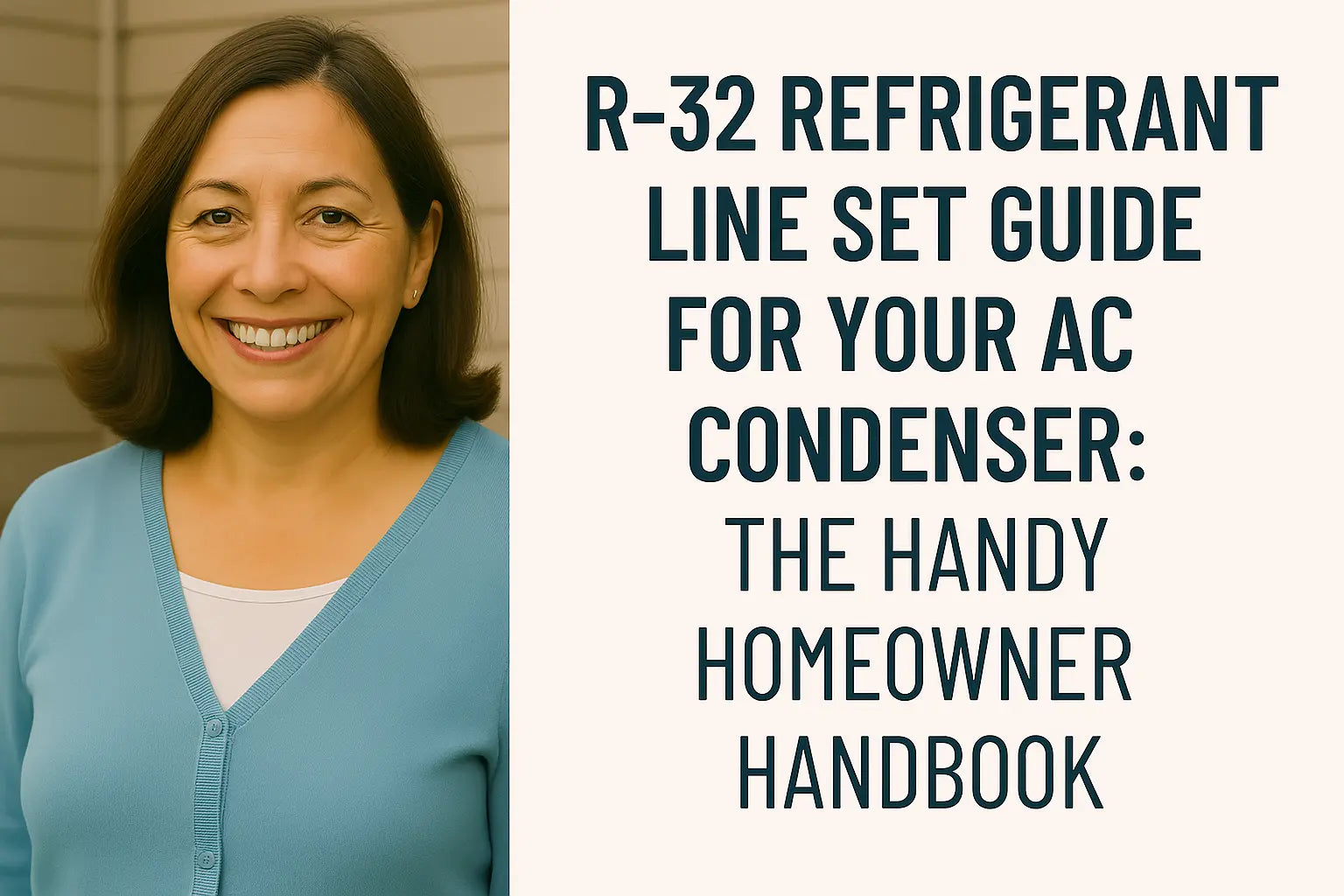Hey Friends!
Hey there, Samantha here! Let’s talk about something that doesn’t get nearly enough spotlight in the world of home cooling: the refrigerant line set. It’s the vital connection between your outdoor R-32 AC condenser and indoor evaporator coil. Without a properly sized, insulated, and installed line set, even the best condenser can’t do its job right.
R-32 refrigerant has its own unique characteristics compared to older refrigerants, which means the line set and its installation require special attention. I know this can sound a bit technical or even intimidating—but stick with me, and I’ll guide you through the essentials in a way that makes sense, whether you’re DIY-ing a replacement or simply want to understand what your installer is doing.
Ready to become the line set expert your home deserves? Let’s jump in!
🧊 What Is a Refrigerant Line Set?
Your refrigerant line set is made up of two copper pipes: the suction line (large diameter, carrying cool vapor back to the condenser) and the liquid line (smaller diameter, sending liquid refrigerant to the indoor coil). Think of them as the system’s circulatory system.
Getting these lines sized and insulated correctly ensures the refrigerant flows smoothly and efficiently, prevents energy loss, and protects against issues like moisture build-up or leaks.
📏 How to Size Your R-32 Refrigerant Line Set Correctly
Why Size Matters
Choosing the right diameter for both the suction and liquid lines is critical. Too small, and you restrict refrigerant flow, making your AC work overtime and possibly causing premature failure. Too large, and refrigerant can pool, also hurting efficiency.
R-32 systems require precise sizing because of the refrigerant’s properties. Your manufacturer’s installation manual will have exact specs based on system capacity.
Here’s a quick reference for common residential sizes (always check your specific model’s documentation):
| System Capacity | Liquid Line Diameter | Suction Line Diameter |
|---|---|---|
| 1.5 to 2 Ton | 3/8 inch | 5/8 inch |
| 2.5 to 3 Ton | 3/8 inch | 3/4 inch |
| 3.5 to 4 Ton | 7/16 inch | 7/8 inch |
| 5 Ton | 1/2 inch | 7/8 inch |
For a detailed explanation and charts, Daikin’s R-32 installation manual is a reliable go-to.
🧰 Insulation: Protecting Your Refrigerant Lines
Good insulation is essential, especially for the suction line, which carries cold vapor that can cause condensation if left exposed.
Closed-cell foam insulation sleeves specifically designed for refrigerant lines are the best choice. Typically, a thickness of 1/2 to 3/4 inch works well, with thicker insulation preferred in humid climates.
Sealing the insulation seams and ends with HVAC-grade foil tape is necessary to prevent moisture intrusion, which can degrade insulation effectiveness and lead to corrosion.
The U.S. Department of Energy provides excellent guidance on HVAC insulation best practices for energy efficiency.
🛠️ Installing Your R-32 Refrigerant Line Set Safely and Properly
Installation isn’t just about connecting pipes—it’s about system longevity and safety.
-
Routing: Avoid long, winding routes. Most residential systems recommend line runs under 50 feet. Longer runs require adjustments to refrigerant charge and possibly larger line sizes.
-
Bends: Use proper tools to make smooth bends—kinks restrict flow.
-
Securing: Use cushioned clamps or brackets to prevent vibration damage.
Before charging, perform a pressure test with dry nitrogen to catch leaks early. Because R-32 is an A2L refrigerant, technicians must use specially rated leak detection equipment. Learn more about these safety protocols at AHRI’s Refrigerant Safety page.
Proper brazing requires purging lines with nitrogen to avoid oxidation inside pipes, which can degrade system performance over time.
🔍 Troubleshooting Common Refrigerant Line Set Issues
Here are a few red flags to watch for:
-
Condensation or Water Drips: Usually means damaged or missing insulation. Replace or repair insulation to avoid corrosion.
-
Refrigerant Leaks: Hissing sounds, oily residue, or weak cooling can indicate leaks. Because of R-32’s flammability, refrigerant service should only be done by certified HVAC professionals trained in A2L refrigerant handling.
-
Corrosion: Check exposed copper pipes periodically, especially in coastal or humid areas.
🔄 Maintenance Tips for Long-Lasting Line Sets
Simple upkeep can keep your refrigerant lines working smoothly for years:
-
Inspect insulation yearly and patch or replace damaged areas.
-
Keep outdoor lines clear of plants, debris, and lawn equipment.
-
Have your HVAC system professionally serviced annually, which should include leak checks and pressure tests.
If you want to learn more about routine maintenance that protects your HVAC investment, check out Carrier’s homeowner maintenance tips.
🌎 Why R-32 Demands Extra Attention
R-32 refrigerant’s mild flammability means following updated safety standards is critical. Only technicians trained to handle A2L refrigerants should work on your system, and using proper leak detectors and tools is mandatory.
For a deeper dive into the regulations and safety standards shaping R-32 use, visit the EPA’s Section 608 Refrigerant Handling page.
🏁 Samantha’s Final Thoughts
Thanks for sticking with me on this deep dive into refrigerant line sets! Though often overlooked, they’re vital to the safe, efficient operation of your R-32 AC condenser.
Remember, getting the line size right, insulating well, and following proper installation and maintenance practices protects your system and your family. If you’re planning to DIY, always double-check your model’s specs and don’t hesitate to call in a pro trained with R-32 systems.
If you’re still shopping, check out The Furnace Outlet’s R-32 AC condenser collection to find the perfect match for your home.
Trying to figure out if you need to call a professional? Visit my guide: Tackling Your AC Condenser.
Stay cool, stay smart, and catch you next time!
💙 Samantha, Home Comfort Advisor







